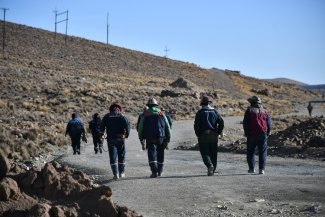“Our demands for the legislative elections”. The sentence is projected onto a screen behind a podium in a house on a housing estate in the far east of Berlin, a few weeks before Germany’s legislative elections on 24 September.
The local branch of the German trade union confederation (DGB) has invited three candidates from left-wing parties – the social democrats (SPD), Die Linke (the radical left) and the Greens – to come and talk about their programme regarding labour.
In this poor neighbourhood of grey tower blocks, the left-wing neo-communist party Die Linke usually leads the polls. It won nearly 33 per cent of the vote in the last legislative elections in 2013. The far-right also has a foothold. Four years ago, four per cent of the neighbourhood’s electorate chose to vote for the neo-Nazi NDP (National Democratic Party of Germany), while another six per cent voted for the then newly-created AfD (Alternative für Deutschland, Alternative for Germany).
The party has made a clear shift to the right since then, taking a xenophobic, Islamophobic, homophobic and anti-women’s rights stand, and moving closer to groups such as Pegida, which organised the anti-Muslim demonstrations in the east of the country in 2014.
In the 2013 local elections, the AfD nearly quadrupled its vote in the Berlin-Marzahn district, reaching 23 per cent.
On this August day, in front of an audience of about 100 people, three-quarters of whom seem to be over 60, the trade union official speaks from the podium to underline the still precarious situation facing many workers in the German capital. And Petra Pau, a representative of Die Linke who has been in the Bundestag since 1998, criticises the differences in salary that still exist between workers in the west and those in the east of Germany, inequalities still written into the text of their collective agreements.
The branch union did not want to invite the AfD candidate to come and speak. But she has invited herself into the meeting room however, with a group of men who appear to be party activists. They seem determined to disrupt the meeting, interrupting the moderators, and commenting on everything that is said, loudly enough for some of the audience to be unable to hear the speakers on the podium.
In this disadvantaged neighbourhood where the unemployment rate is 9.4 per cent (compared to the national average of 5.6 per cent) Germany’s new far right party has found fertile ground. Although its leaders and activists are well qualified and well-off, the AfD attracts many voters from amongst the poorest Germans.
The illusions of the German economic miracle
There are plenty of poor people in Germany. Overall, Germany in 2017 is doing well economically, with one of the lowest unemployment rates in Europe and a growing economy. But the figures hide a more nuanced reality.
Although according to the German employment agency the country has an unemployment rate of 5.6 per cent, or 2.5 million people, the rate of ‘under-employment’ is 7.7 per cent, which is 3.5 million people.
Those considered ‘under-employed’, but not counted in the unemployment figures, include for example, the long-term unemployed aged over 58, the unemployed who are in some form of training or getting qualifications, or the unemployed with a ‘one euro job’ – part-time, short-term jobs, which are paid one euro an hour on top of the minimum income.
“For the unemployed, it is still just as difficult [as it has been in the past] to find work,” says Jörg Böhm, the volunteer chairman of the unemployed workers’ association of Mecklemburg-West Pomerania, a federal state in north-east Germany, where unemployment rates are over 8 per cent.
“The people who are no longer included in the unemployment statistics in our region are not taken out of the figures because they have found a job but because they are no longer considered economically active, either because they are getting old or because they are seen as no longer looking for work because they are caring for children or the elderly at home,” adds Böhm.
Germany’s unemployment figures are certainly better than 15 years ago, when they were above ten per cent. But there are still many people in the country who are virtually unemployed or who have very insecure jobs.
There have never been so many people on temporary contracts, for example, as there are today. Germany also has seven million low-pay workers.
The introduction of a national minimum wage for all since 1 January 2015 should help overcome the proliferation of low wages in Germany. It is low, however, at €8.84 gross (US$10.40) per hour since the beginning of 2017, while in France, for example, the minimum wage is €9.76 gross (US$11.50). Furthermore, the long term unemployed do not have the right to the minimum wage for the first six months after they are hired. “Often contracts for former long-term unemployed workers do not exceed six months and then they find themselves out of work again,” says Böhm.
So what do Germany’s political parties have to say about unemployment and the working poor? Chancellor Angela Merkel’s Christian Democrat Union (CDU) uses the slogan “For quality jobs and decent pay” on its posters, and has a target of full employment by 2025 in its programme. But it says nothing about the working poor.
The SPD wants to extend the period of unemployment compensation for people in training. This would be a reversal of the Hartz reforms, introduced at the beginning of the 2000s, by the social democrat chancellor, Gerhard Schröder. The reforms drastically reduced unemployment allowances and sowed the seeds for the massive low-pay economy we are seeing in Germany today.
The Greens are calling for an increase in the minimum wage, without saying how much, and for a broader coverage of workers under sector-based collective agreements. Die Linke wants a gross minimum wage of €12 (US$14) an hour and a basic minimum income for the unemployed of €1050 (US$1239).
According to the opinion polls this radical left wing party will still only get about 8 per cent of the vote, the same as its 2013 results. The Greens are also hitting a ceiling of about 7 or 8 per cent. The SPD is on 24 per cent. Its candidate, Martin Schulz, initially stirred a wave of enthusiasm when he was nominated in January. But the former bookseller, who served as President of the European Parliament between 2012 and 2017, and as an MEP since 1994, has not managed to keep the momentum going.
It is Merkel’s CDU that remains ahead of the game, leading the polls with 40 per cent of declared voting intentions. A left-wing coalition composed of the social democrats, the Greens and Die Linke is looking less and less likely.
Merkel, who has served as Chancellor since 2005, seems to have every chance of continuing with a fourth mandate.
The AfD party, credited with 7 to ten per cent of voting intentions, is expected to take its place under the Bundestag’s glass dome.
“The fear of unemployment and a sense of insecurity about the future benefits the populists on the far right,” said the president of the German trade union confederation, Reiner Hoffmann, facing the prospect of seeing such a party enter the German parliament.
“Our response can only be: more security for workers thanks to collective agreements and co-decision in enterprises, a labour market that favours good working conditions and limits precarious employment. Those who want more temporary jobs, more precarious employment, more deregulation of working time, those people simply don’t understand what is at stake.”









